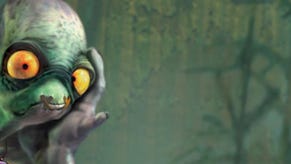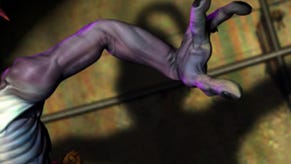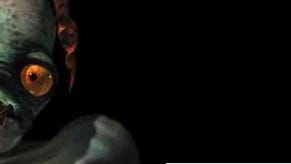Oddworld Abe's Oddysee interview: stick it to the man
Oddworld: Abe's Oddysee is one of the most unique games of our time. VG247's Dave Cook spoke with creator Lorne Lanning about its origins and future.
There are many truths of the game industry that ring true no matter what year, generation or country you look at, but few resonate quite so profoundly as new IP being a huge financial risk.
Money talks and bullshit walks, but unless you're a million dollar entity, success in this market is never guaranteed. The Oddworld series goes against the grain so defiantly that it was always going to run into trouble at some point in its lifespan.
Initially planned by co-creators Lorne Lanning and his partner Sherry McKenna as a five-game series, the Oddworld Quintology only saw the release of three core games - not counting the originally unplanned sequel Abe's Exoddus. The first title, Abe's Oddysee launched on PSone in 1997.
The developer's third game, the critically-acclaimed but criminally under-marketed Stranger's Wrath would be the studio's last release before receding to the sidelines in 2005. But now, in collaboration with British studio Just Add Water, the franchise is back in a big way.
Oddworld: New N' Tasty! is an HD remake of the first game - as in, an actual remake from top to bottom - and it's looking rather lovely indeed. The game will launch in due course, but what comes after that is anyone's guess.
At Eurogamer Expo, VG247 caught up with Lanning to discuss the origins of the Oddworld: Abe's Oddysee, and why the current climate of indies and digital distribution is perfect for a full-on Oddworld revival.
The million unit dream
We're not even underway with our interview but we can already tell that Lanning feels like a man reborn, a person thankful to have a second chance to let his creations shine. His energy is heart-warming after everything he's been through.
It's a great thing to see in an industry riddle with lay-offs and closures, so we ask him just how thankful he feels for Abe's success, and if he thought all of this would have been possible back at the launch of his studio in 1994.
"You know, the amount of money we borrowed to make Abe's Oddysee - he had to succeed," Lanning recalled, "He had to sell millions of units. He just had to man. I had to convince people that it would before I got the money, and then I actually had to deliver."
“That impact was a little more than I’d kind of hoped for – the longevity of it. The number of people with Abe tattoos, and all that is pretty phenomenal. I didn’t really see that then.”
"But that said, what I never expected - I worked for it, I designed for it, but I never actually expected it - was that 15 years later, gamers would still have this passion, and that we would still be receiving emails about it."
"I mean, we always designed Abe for the downtrodden, because that's who I feel most of us are. Now it's so much more clear, but we still get emails from people about how it really changed their lives at really critical times. Like, they decided not to jump off that cliff."
"That impact was a little more than I'd kind of hoped for - the longevity of it, and the number of people with Abe tattoos, all that is pretty phenomenal. I didn't really see that then."
Lanning was lucky that his studio retained ownership over the Oddworld IP for so long. After all, this is a business teeming with big publishers vying for ownership over new franchises.
Calling it 'splitting the baby' - a legal term often used to explain part-ownership of a license or other asset, Lanning explained that he wasn't too eager to hand over control of Oddworld to publishers readily, for fear of the quality suffering.
Lanning explained to us that digital distribution and a strong relationship with Just Add Water made Oddworld's revival possible, but noted that any profit made strictly goes back into paying company wages and funding projects.
Rock n' roll standards
The secret to making the Oddworld franchise reach new prominence today is reinvestment, and making sure that money is used wisely. That way Lanning and Just Add Water need never turn to a big publisher ever again.
"It started just by getting Abe's Oddysee and Exoddus on Steam, that was the beginning of us self-publishing. It worked out phenomenally because then we had the Oddbox, Stranger's Wrath HD and now Abe's Oddysee New N' Tasty."
"Abe is something that resonated so well, and for so long that to-date, there may be about five-plus million units sold. That's not phenomenal by today's standards, but by rock n' roll standards, that is huge."
“That’s how we see it. We’re a rock band, not big business people with an exit strategy.”
"That's how we see it. We're a rock band, not big business people with an exit strategy. When I talked about babies split in half, if you look at the industry, there's babies split in half everywhere - Halo, the BioWare games and others."
"The initial passion is gone, but for us if the returns are bigger, we can start to take bigger and bigger bets. This allows us to do something that would be difficult for a publisher, which is to say, 'hey, we're going to love making these games as developers', and put as much love into them as we've always done."
"If I look at the landscape now it's like, if I'm a big publisher and I don't make a 5x return on my game in the first week, I'm dead. But now, at 50,000 units digitally, you have a business. It's self-perpetuating."
That freedom didn't happen for Lanning overnight of course, so we get to the real meat of the conversation - the game that started it all - Oddworld: Abe's Oddysee.
Odd origins
We ask Lanning what he set out to achieve when conceptualising Abe's first outing and its dark, wacky world. After all, it wasn't exactly conforming to industry trends, so it posed a big risk for the studio.
"Oddworld itself was based on the idea that we're living in an unsustainable world and we need to wake up. I'm an anti-capitalist and proud of it because capitalism is evil. the beautiful thing is that today, people are seeing that more clearly."
"In reality, a lot of what drove the creation of the content is more clear to the audience today, that basically, we're all getting screwed. What inspired the games was, I knew what was happening with fast food companies and the deforestation of South American rainforest."
”The creation of Abe was driven by deforestation and what was happing with diamond miners, and how indigenous cultures were becoming mandated to become financially dependent on bigger cultures.”
"I knew it, and I knew most people at the time didn't. I would talk to professors and people who were meant to be intelligent, but they were clueless. That need to say, 'look, we need to pay attention to these things' was there, but how could we do that with a twisted funnybone?'"
"How can that be inspiring to people who know they're getting the shaft? So the creation of Abe was driven by deforestation and what was happing with diamond miners, and how indigenous cultures were becoming mandated to become financially dependent on bigger cultures."
"When we got to Munch's Oddysee, that was about what was happening in the pharmaceutical industry on the legal end, and with animal testing in multi-billion businesses."
"Stranger's Wrath was more about me thinking, 'where's the warrior in all of this? Where's the rogue samurai? I mean, my dad was on nuclear submarines for 17 years, and through that I saw true patriots. But those same guys are only now realising just who they're working for."
Designing Abe
But what about Abe's quirky design? He's a Mudokon, forced into working at food processing plant Rupture Farms. After learning that his people are next on the menu, he decides to escape the rusting factory and liberate his people.
Lanning explained his collaboration with Oddworld artist Steven Olds, "He was an amazing guy. He was self-taught but you've never met a guy with more discipline, he's the Lance Armstrong of production design. He was a master."
"But what I was doing was trying to come up with in Abe was the embodiment of the absolute downtrodden. I wanted what I was seeing in the heartbreaking pictures of guys covered in mud, emerging from the diamond mines of Bolivia, with their managers carrying M16s."
"I wanted that, so we went back and forth. There was another thing I wanted but we haven't gone into too much detail with was Abe's little ponytail. One of the things I noticed from fishing - which is my first love - is that I would see the same species of fish looking very different depending on the quality of the water it lived in."
"I later learned that you could take that fish and put it in better water, then after an amount of time it would change back into that beautiful thing. Now we get to Abe, and the Mudokon. In Rupture farms they are grey, their ponytails have shrunken."
“The key is actually in creating the really difficult challenge that must be solved, and that requires a grand solution. Once you solve it, you look really smart.”
"But as they start getting healthy, being around trees, eating organic food instead of processed, and just finding themselves again, the real colour starts to come back, and their hair grows long.
"We need more successes to make new games that show all of that, but there is a lot more inspiration and logic that drives those characters so far."
While Lanning's inspiration and design concept for Abe is admirable, we ask him if he ever felt worried that Abe, who is largely a pacifist wouldn't be an attractive lead in 1997, in the same decade that produced Doom and Metal Gear Solid.
"Abe was never going to carry a gun, and some of our designers at the time were like, 'you're just nuts, he needs a gun', so I said 'no he doesn't, he needs a solution'. I say this often: that the essence of what appear to be brilliant ideas, is not necessarily brilliance."
"The key is actually in creating the really difficult challenge that must be solved, and that requires a grand solution. Once you solve it, you look really smart. In the case of Abe it was more than embodying what we knew the audience was looking for, it was that we wanted to take the opposite approach."
"He can never carry a gun, ever, and that is what birthed his power of possession. If you look at it as a designer like, how do we give him a gun and then take it away, but that it still feels ok?"
"It doesn't feel limiting, it just feels like a power-up in this instance, and that is what drove possession. It was a good answer to that problem because we were dealing with this spiritually indigenous people that had kind of lost their roots."
"They're like the Aborigines in that they know something we've forgotten, and we need that recaptured."
Gamespeak
Oddworld games have always included a system called Gamespeak, which gives players the ability to have characters talk which in turn triggers a response from NPCs, such Abe asking Mudokons to follow him, or even scolding them if they get out of line.
Lanning explains why his team implemented the system in Abe's Oddysee, "What I felt was that I had no emotional connections to games on-screen. The closest I came was Prince of Persia, and I realised the reason for that was Jordan Mechner's wonderful rotoscoped character animations."
"Because it felt more lifelike and that the prince dies so suddenly and horribly, I was like, 'oh!'. I remember there was like a dozen of us playing it one night smoking bongs, and playing Prince of Persia."
"They were all like, 'jump, jump!', so I did and I fell to my death, then everyone was like, 'aaaah!' We were like totally traumatised, and I thought it was great. It was valuable."
"So in an effort to make Abe more emotionally engaging, we had to show more character. I was thinking like, 'well, how can an action embody more emotion and intent than a punch?'"
"I remember there was like a dozen of us playing it one night smoking bongs, and playing Prince of Persia. They were all like, ‘jump, jump!’, so I did and I fell to my death, then everyone was like, ‘aaaah!’"
"If it can be a word that gets a cute little response like 'Hello?', 'Hello!', or 'OK?', 'OK!' [In Abe's voice], then you immediately have more of a feeling of a life form, and less of a piece of art that's just engaged in a challenging experience."
"That was a bit part of driving it, and in Stranger's Wrath we made that process simpler with one button, but more complex on the AI end. That all came from lessons learned, because Abe was a complicated game at the time."
"We wanted you to feel responsible for Abe, and we wanted you to feel bad if you did bad for him. Most importantly, we wanted you to feel bad for character, not for your score. There's a huge difference."
"Gamespeak - I think - was the real beginning to get that feeling of, instead of throwing punch, you're throwing a helpful word, or humour. Then you have the idea of saving guys rather than killing them."
"But we had to make sure that if you wanted to kill them, we'd facilitate that beautifully, so that we still have integrity rather than becoming hooligans."
What comes next?
Lanning's inspiration for the weird and wonderful inhabitants of Oddworld come from many places, but these creatures all exist for the same reason. They exist to induce empathy in players, to test their ability and perhaps most of all, to provide fun and warm memories.
"That was always my goal, to create that sense of empathetic emotion and connection so that you'd feel for them. But if you wanted to be cynical about it and kill everything, we had to facilitate that where Nintendo wouldn't with Mario."
"You could never do that in a Nintendo game, and that annoyed me because sometimes I'm a sick bastard and I should be allowed to exercise that. We wanted that in the gameplay to give Oddworld an ethical message"
That message hasn't ended yet in Lanning's eyes, and thanks to his collaboration with Just Add Water and renewed interest in the franchise, we could just see the release of brand new chapters in this stunted story.
"In my opinion, Oddworld hasn't really gotten started yet," Lanning stressed, "I've tried some other business ventures and I've failed because I'm trying to earn the 20-40 million dollars I need to put it back into the franchise."
"I mean, I don't have kids. But then again I do - they're green, they're in wheelchairs and they've got horns. Those characters are my kids - quite literally - because I'll never have other children."
"They're the ones, and I feel like they've just gotten started."













